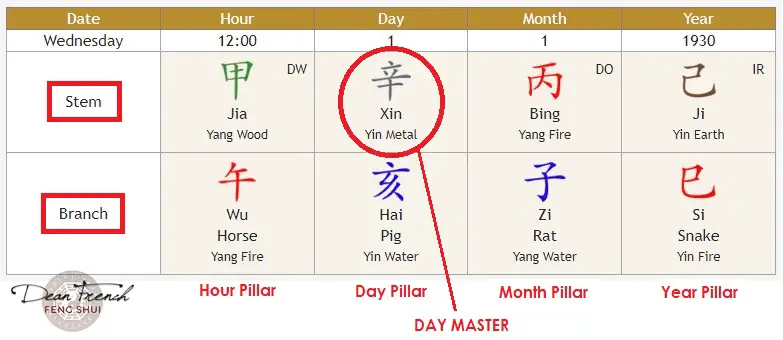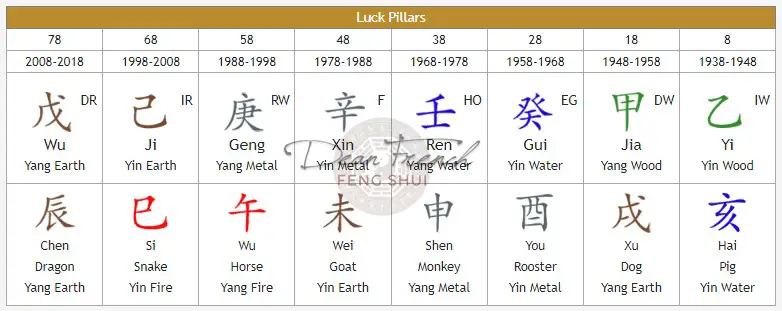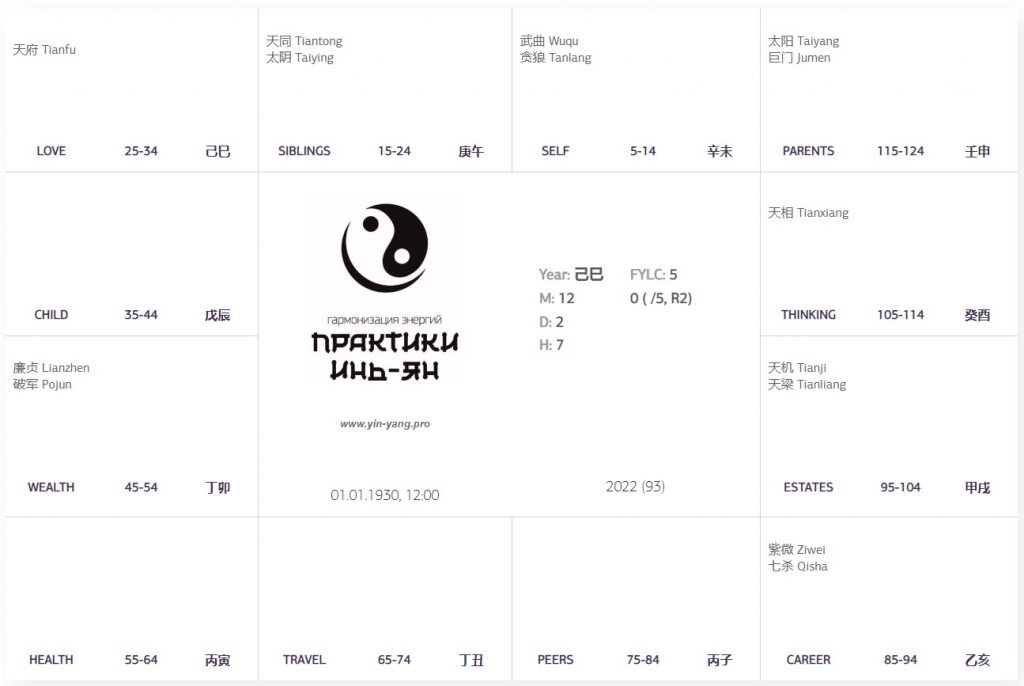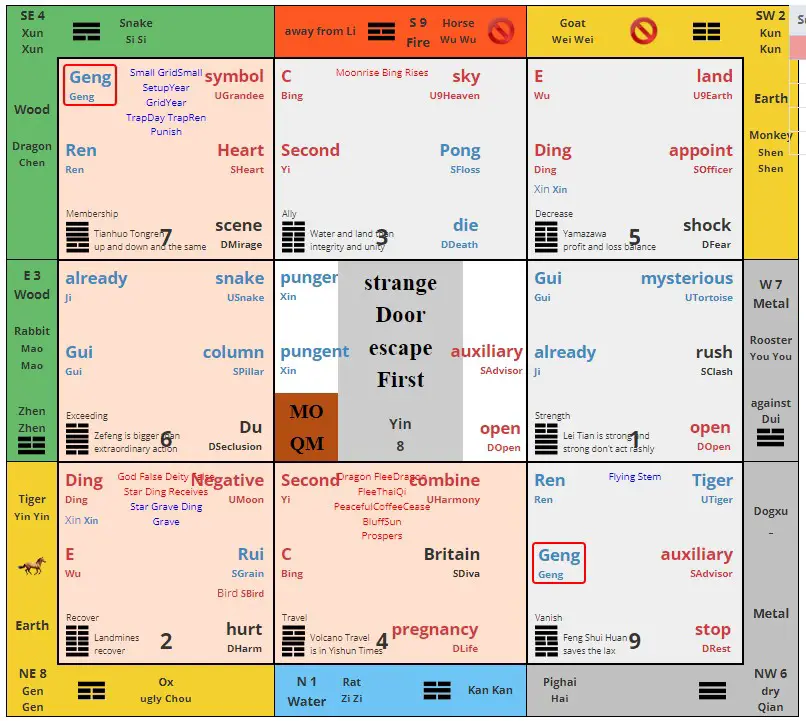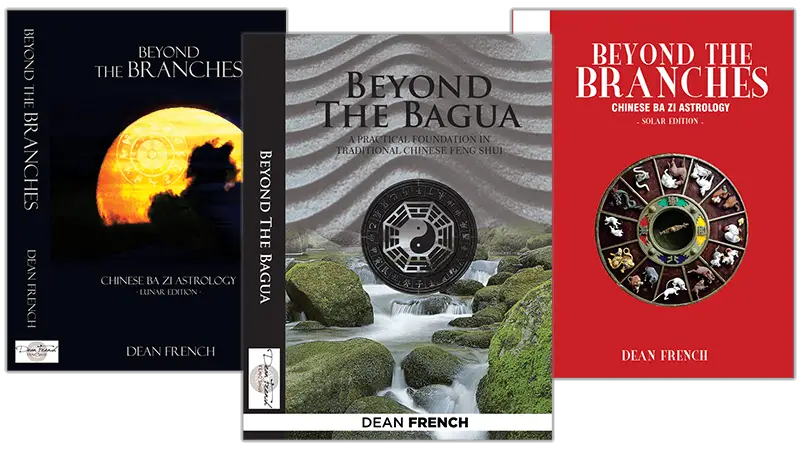The Beginner's Guide to Chinese Astrology
What if Shakespeare was wrong and the fault really is in the stars?
Chinese astrology includes many different systems, including Sheng Xiao, BaZi, Zi Wei Do Shu, 28 Constellation Astrology, Iron Plate Divination, Nine Star Ki, Qi Men Dun Jia, and Xuan Kong Da Gua. Most people are familiar with Sheng Xiao, a system based on 12-year cycles using animal signs.
This article provides beginners with basic information regarding Chinese astrology, including its origins and development. We’ll dive into the differences between Western and Chinese astrology and provide additional insight into the many types of Chinese astrological systems. Finally, we’ll examine how people can utilize Chinese astrology and incorporate it into Feng shui philosophies.
Table of Contents
Mysterious Origins of Chinese Astrology
The origins of Sheng Xiao — the twelve-year astrological system — are quite mysterious. Historians cannot agree on when Chinese astrology began, although they generally agree that the twelve animals appeared during the 5th century during the Zhan Guo period. Despite being unable to pinpoint the exact origins, experts believe that Chinese astrology exploded in popularity during the Han Dynasty, from 206 BC to 220 AD.
What Is Chinese Astrology Based On?
Chinese astrology is an astrological system based on a 12-year cycle. An animal represents each cycle and corresponds to a specific year.
As with Western astrology, there are 12 different Zodiac signs in Chinese astrology. Instead of your birth month, though, your sign is determined by the year that you were born. 2008, for example, was the year of the Rat, and 2019 was the year of the Pig.
Most Western countries are at least somewhat familiar with the animals that make up the Chinese zodiac. However, there are many other attributes that play a role in Chinese divination. The many systems incorporate stems, branches, pillars, polarities, planets, and elements, all of which play a role in a person’s characteristics and potential life path.
Chinese astrology is based on ancient Chinese astronomical phenomena and the lunar calendar. The practice implements various principles from Chinese philosophy, including Yin and Yang and the “Three Harmonies.”
The Heavenly Stems, the Earthly Branches, and the 60 Pillar System Called “Jia-zi”
Chinese astrology is a bit complex, so it’s important to start with the basics. Here, we’ll dive into the Five Elements, Heavenly Stems, and Earthly Branches.
The Five Elements
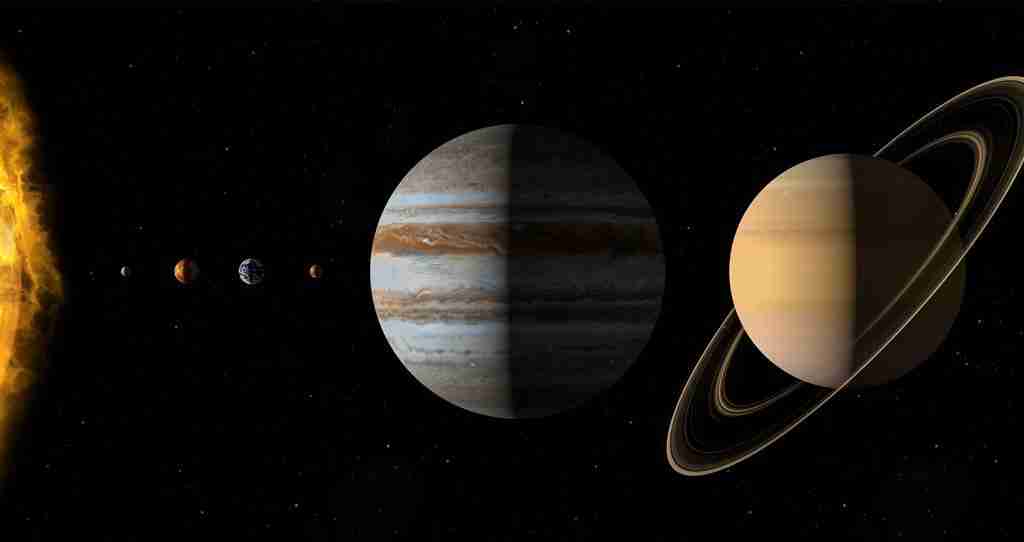
The Special Role of Planets
As with Western astrology, the planets play a special role in Chinese astrology. The planets that are easily visible (Mercury, Venus, Mars, Jupiter, and Saturn) are connected to the five elements: (respectively, water, metal, fire, wood, and earth). And these planets play a special role in the personality of a person depending on when they were born.
Proponents of Chinese astrology pay special attention to the year, month, day, and even the hour in which a person was born. Each of these may correspond to different planets (as well as the sun and the moon) that helps us learn more detailed information about someone’s personality and, potentially, their future.
Wu Xing (五行), or the Five Elements, are five materials, each corresponding to different states of change. Elements also align with specific cardinal directions, planets, seasons, colors, and even bodily organs.
Based on where an element falls within a Chinese astrological chart and how it relates to other aspects, practitioners can determine whether an individual might experience financial success, have a happy marriage, or even if they’ll experience health issues.
The chart below shows each element, its corresponding planet, and the related attributes.
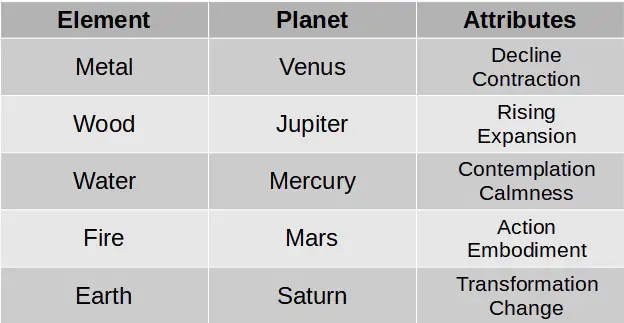
The Heavenly Stems
Now that you’re familiar with the basics of the Five Elements, let’s move on to the Heavenly Stems (sometimes called the “Celestial Stems”).
In ancient China, the people developed the Heavenly Stems and Earthly Branches to keep track of time. They based these systems on phenomena observed within the heavens. As time progressed, these time-keeping systems became integral parts of Chinese culture, with evidence suggesting they were used for divination and Feng shui.
Each of the ten Heavenly Stems features a fixed element and polarity (Yin or Yang). Yin represents decrease, decline, and contraction. Yang represents increase and growth.
Below are each of the 10 Heavenly Stems, along with their corresponding polarity and element:
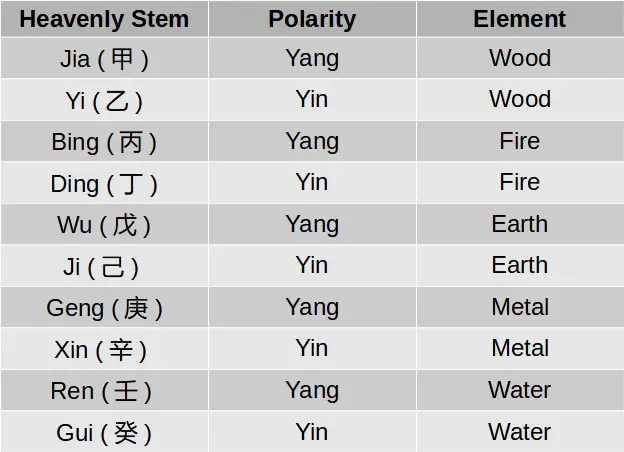
The Earthly Branches or Terrestrial Branches (Chinese Zodiac Animal Signs)
The Earthly Branches within a Chinese astrological chart use the year, month, or hour of a person’s birth. To find the Earthly Branch for the year of birth, you select the animal that corresponds to your birth year. For example, a person born in 1988 would have Chen (辰) as their Earthly Branch based on the year of birth.
The table below shows each Earthly Branch, its associated animal sign, fixed polarity, and element:
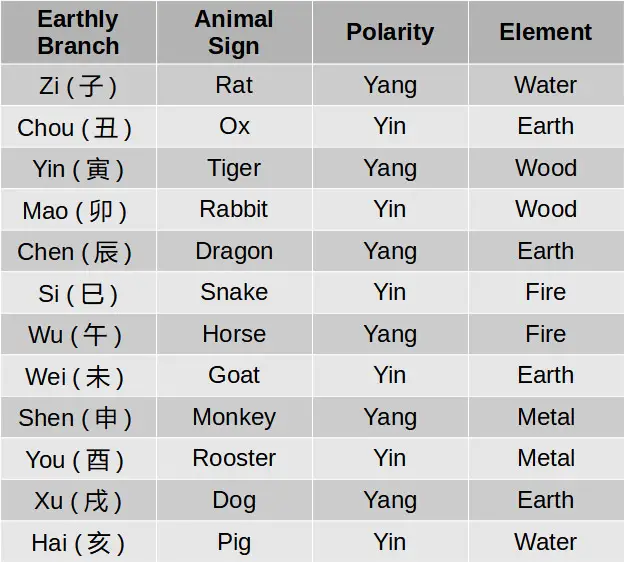
Each Heavenly Stem combines with an Earthly Branch Yang with Yang, and Yin with Yin, to create a sexagenary (60-year) cycle. This cycle is referred to as the “60 Pillars” or the “60 Jia-Zi”.
60 Pillars (Jia-Zi)
The 60 Pillars divination technique utilizes traditional methods developed by ancient Chinese astrologers. The Pillars begin with the Wood Rat (Jia-Zi). Each Pillar explains multiple aspects of a person and their potential life trajectory. For example, the Pillars may shed light on:
• Personality
• Abilities and Natural Talents
• Work Ethic and Approach
• Love Life
• Friendships
• Family
• Health outlook
The idea is that a person’s destiny can be determined using the two sexagenary cycle characters assigned based on their birth year, month, day, and hour.
The Difference Between Chinese and Western Astrology
Western and Chinese astrology are similar systems, each using dates, lunar cycles, planets, and elements. However, each divination system views cycles and other aspects from alternative perspectives and may approach charts in different ways. It is the approach and perspective that make these two astrological systems very different, and yet many times, the results or predictions are very similar.
Other differences between Chinese and Western astrology include:
• Symbology. A Chinese myth claims that the animals earned their place in the zodiac after competing in a race. They’re ranked from first to last — the rat won thanks to its slyness, whereas the Pig was last due to its proclivity for distraction. Western astrological signs are based on constellations. For example, Gemini is associated with May/June as that’s when the Gemini constellation is at its zenith.
• Cycles. Basic predictive Western astrology utilizes a 12-month cycle, with each monthly period corresponding to a certain sign. The Chinese zodiac uses a 12-year cycle, with each year representing a different animal. Of course, when you dive into the mathematical calculations behind the more complex astrology sytems, there are many crossovers. For example, the change of month dates in the Chinese Solar Calendar correspond to the mid-point of each western zodiac sign.
• Particulars. Chinese astrology incorporates stems, branches, elements, and polarities. Western astrology focuses mainly on planets, signs, houses, and aspects (angles formed in the chart).
• Calendars. Western astrology uses the solar calendar based on Earth’s orbit around the sun. Each month begins on a set date and lasts between 28 and 31 days. Chinese astrology uses both the Chinese Solar and Chinese Lunar calendar depending on which system you are utilizing.
• Elements. There are five elements in Chinese astrology (fire, earth, metal, water, and wood), with each correlating with an inner planet. In Western astrology, there are four elements, each focused more on personality characteristics and assigned to multiple planets.
• Moon Phases – While Western astrology does incorporate moon signs, Chinese astrology places a strong emphasis on the phase of the moon during a person’s birth. This information is used to determine the individual’s temperament. For example, those born on a New Moon are adventurous, whereas those born on a Full Moon prefer routine and lack spontaneity.
How Compatible Are Western and Chinese Astrology?
Western and Chinese astrology are somewhat compatible. Many astrologers combine the two astrological systems to create a more in-depth look at compatibility, life paths, challenges, and personality traits. Combining the two systems can shed additional light on influences that shape an individual.
There are both simple and complex ways to combine Western and Chinese astrology. The simplest way is to pull up a Chinese astrological chart and compare it with a Western natal chart.
You can also combine the zodiac signs to compare and contrast. However, this doesn’t provide as much information as viewing full charts that utilize stems, branches, planets, elements, and so on.
Simple Way to Combine Chinese and Western Astrology
Here is an easy way to combine your Western and Chinese zodiac signs to help get more insight into your personality traits.
1. Find your zodiac signs. For example, if you were born on December 28, 1988, you’re a Capricorn in Western astrology and a Dragon in the Chinese zodiac.
2. Compare the traits. Examine the attributes of the Capricorn and the Dragon. You may find some conflicting information, but there are bound to be pieces that help tie together questions you might’ve had about your personality. For example, you might be a practical person with a dangerous adventurous streak. Capricorn is a grounded individual, although the Dragon can sometimes be adventurous and recklessly bold.
After examining your signs in both Western and Chinese astrology, try looking at a friend or romantic partner’s signs. You may find deeper insight into their personalities or even discover more about your compatibility.
Combining Western and Chinese Astrological Elements
Once you’ve looked at the basic signs, you can go a little further by incorporating your elements from both Western and Chinese astrological systems.
Use the chart below to look at your element(s) associated with your Western and Chinese zodiac signs:

It’s important to note that in Chinese astrology, while each animal is associated with a certain element, you could have a completely different Heavenly Stem element based on the year of your birth.
For example, the chart above indicates that Dragons are associated with the Earth sign. However, those born in 1976 are Fire Dragons. You can determine your particular element (and not just the sign associated with your zodiac sign) using the following chart based on your birth year:
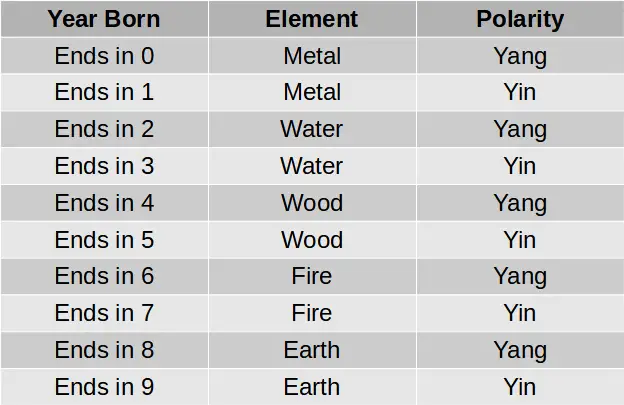
Like this article? Tap to share
There are many different attributes associated with each sign and its element based on birth year. For example, a Metal Monkey is intelligent, innovative, and full of talent, although they may tend to talk too much and get themselves into trouble. Earth Monkeys are also smart, but they tend to be better at controlling themselves and solving problems with a clear head.
Harmonious Elemental Pairs
When considering the Five Elements, remember that there are complementary and conflicting pairs. Below are the harmonious elemental pairs and the examples of why they work well together — these examples should serve to help you remember the harmonious relationships:
• Wood & Fire – You need wood to start a fire.
• Fire & Earth – Fire revitalizes the earth with nutrients.
• Earth & Metal – The earth contains metal.
• Metal & Water – Metal transports water.
• Water & Wood – You need water to nurture wood.
In the weak-strong method of BaZi, the ultimate goal in a chart is balance. If there are multiple conflicting aspects, the chart does not indicate proper balance and suggests challenges. Those challenges depend on where in the chart the elements conflict.
Western Zodiac Signs and Their Chinese Zodiac Animal Equivalent
Some astrologers have combined the Western zodiac and the Chinese zodiac by comparing each constellation sign with the Chinese zodiac animals to come up with equivalents. They base these equivalents on personality traits alone.
The chart below shows the Western zodiac signs and their Chinese zodiac equivalents.

Types of Chinese Astrology
As mentioned earlier in this article, the Chinese zodiac isn’t the only form of Chinese astrology. There are dozens of Chinese astrological systems, many of which are used in combination to form a more advanced, in-depth look into a person’s current life, future, and characteristics.
Let’s look at a few of these systems.
BaZi (Four Pillars of Destiny)
In “The Heavenly Stems” section of this article, I touched briefly on the ten Heavenly Stems and the twelve Earthly Branches. BaZi, also known as the Four Pillars of Destiny, utilizes the Heavenly Stems and Earthly Branches to determine a person’s fate. The Heavenly Stems and Earthly Branches combine to form one of the sexagenary (60-year) Pillars. Each of the four pillars in Ba-Zi represents the year, month, day, and hour of birth.
Through the BaZi astrological system, the practitioner develops two charts. The first table charts the Heavenly Stems. The second row of the table features the Earthly Branches. There are “trunks hidden among the branches” within a third row.
The second table, also known as the “Pillars of Luck,” feature multiple column, each representing a 10-year period in an individual’s life.
The relationship between the aspects (zodiac, elements, and polarities) in the chart can determine the destiny of the person seeking divination.
Let’s discuss the Four Pillars and a few examples of conflicting and complementary aspects and what they might mean within certain pillars:
• Year Pillar – The year pillar symbolizes ancestors, parents, and a person’s childhood. This represents the first 16 years of life. Conflicting or incompatible elements may indicate trouble during childhood (i.e., lack of nurturing, poverty, family trouble, etc.). Positive aspects within the year pillar indicate a positive family life.
• Month Pillar – The month pillar represents the immediate family, including siblings and parents. It may aslo pertain to an individual’s career path. This pillar focuses on ages 17 to 32. Conflicting elements within the chart indicate limited support from family members. Harmonious elements suggest success and prosperity within the family.
• Day Pillar – The day pillar involves the self and romantic partnerships. It determines aspects from the age of 33 to 48. Compatible elements suggest a happy family life, prosperity, and a successful marriage. On the contrary, conflicting elements indicate family dysfunction, financial misfortune, and relationship troubles.
• Hour Pillar – The hour pillar symbolizes children, and represents ages 48 to 60. Conflicting elements within the hour pillar may suggest disgraceful children, trouble during your later years caused by your offspring, or general misfortune. Balance within the hour pillar indicates happy children and a peaceful old age.
The Ten Gods
This is where BaZi becomes more complex. The 10 Gods are a representation of the Yin-Yang aspects of the Five Elements and how they relate to the chart Day Master.
For a Wood Day Master – Wood is self, Fire is output, Earth is money, Metal is power and Water is support. We can then split each Element into Yin and Yang to determine how those Elements will affect the chart, and this will depend if they are a Jia Yang Wood or Yi Yin Wood Day Master. Yang Fire will have a different effect for Jia than it will for Yi.
Here is a table of the Ten Gods for reference –

Zi Wei Dou Shu
Zi Wei Dou Shu is a form of ancient Chinese divination and one of the most renowned methods for determining the destiny of an individual. It’s known in the Western world as “Purple Star Astrology.”
Unlike Ba-Zi which focuses on Earth’s orbit around the sun to determine Pillar aspects, Zi Wei Dou Shu utilizes the stars’ positions.
Zi Wei Dou Shu is a relatively simple system when learning only the basics. However, once you dive deeper into the practice, you learn that it’s very complex. It’s quite easy to read charts and find the locations of the stars within the heavens, but there’s much more to it.
Zi Wei Dou chart showing the 12 Palaces or Houses, and the 14 Major Stars courtesy of yin-yang.pro.
There are 108 Stars in total including the majors, lucky, inauspicious, transforming, minor and auxilliary stars. These can have a different meaning depending on the Palace they arrive in, and the stars surrounding them.
In fact, using Zi Wei Do Shu, expert practitioners can explain why things happen instead of simply telling you that something will happen. For example, let’s say that BaZi suggests you’re going to face relationship troubles. You can use Zi Wei Dou Shu to find out the cause of your future relationship troubles.
28 Constellation Astrology
Another Chinese astrological system is 28 Constellation Astrology. In Chinese culture, this method of divination is called “28 Lunar Mansions.”
It’s a system that’s very similar to the way Western astrology works, although the basis of 28 Constellation Astrology focuses on the moon instead of the sun.
Developers of this method designated four regions in the sky and called them the “Four Symbols.” Each region corresponds to a specific animal:
• North – Black Tortoise
• East – Azure Dragon
• South – Red Vermilion
• West – White Tiger
Within each of these regions, there are 28 “mansions” that correspond to the longitudes that the moon crosses as it orbits Earth.
People use this form of divination to learn more about their destiny or life path.
Iron Plate Divination
Considered an accurate (albeit difficult) form of ancient Chinese divination, Iron Plate Divination (Tie Ban Shen Shu) can predict events throughout an individual’s entire lifetime.
This form of divination is uncommon. In fact, it’s so rare that there are legends claiming that only five people at any given time have mastered the practice. Whenever a new master of Tie Ban Shen Shu rises, legend has it that another master has died. This is not true of course, however there are not many people in the West that know how to utilize it.
Learning this method of divination is difficult due to the fact that many written works about Tie Ban Shen Shu include contradictory and misleading information to prevent common people from gaining access to this sacred knowledge.
So, what is Iron Plate Divination?
This form of divination includes 12,000 individual texts or poems. The texts can be applied to a person’s life depending on the outcomes of specific procedures. The procedures utilize multiple forms of Chinese metaphysics, including:
• Four Pillars (Ba-Zi)
• Heavenly Stems
• Earthly Branches
• Numerology
• 64 Hexagrams (I-Ching)
• Six Familial Relationships
After performing multiple calculations using the methods from the abovementioned systems, the practitioner combines them to form a complete, comprehensive reading covering the person’s entire lifetime.
Nine Star Ki
Nine Star Ki is a popular numerology-based Japanese astrological system often incorporated with Feng Shui since it’s foundation is in the Chinese Luo Shu or Later Heaven Bagua.
Using nine-year and nine-month cycles of Qi (vital energy), each person receives two (sometimes three) numbers. The numbers indicate different states in a person’s mental and physical growth, as well as their life experiences. Practitioners calculate the numbers using the individual’s birthdate.
The first number is the Honmei Star. It’s also referred to as the:
• Principal Star
• Adulthood Star
• Year Number
The Honmei Star indicates a person’s purest self, their heart, karma, and their spirit.
The second number is the Getsumei Star. It’s also referred to as the:
• Character Star
• Childhood Star
• Month Number
The Getsumei Star represents a person’s physical features.
In the Western world, practitioners may supply a third number. This number, often called the “Energetic Number,” represents a person’s external self, or the way that other people see them. This number isn’t based on a specific date, but is determined by the Honmei and Getsumei Stars.
Qi Men Dun Jia
Interestingly, the development of Qi Men Dun Jia was for the Chinese military to develop strategies and tactics to take down the enemy in war.
Today, people look to this form of divination to obtain information, usually surrounding the specific time period when the question is asked.
The information utilizes astronomical observations and other parts of Chinese metaphysics, including:
• Yin and Yang
• Five Elements
• Eight Trigrams
• Heavenly Stems
• Earthly Branches
• Twenty-Four Solar Terms
The practitioner uses a 3 x 3 board featuring 9 sections, including:
• Heaven Plate
• Earth Plate
• Spirit Plate
• (8) Gates
• Star Plate
There are 1,080 possible configurations using the board. Information obtained is time-sensitive, as it references aspects based on when an individual asks a question.
Xuan Kong Da Gua
Xuan Kong Da Gua allows users to learn more about a specific day to help plan for activities such as weddings, parties, or even determining a potential scheduled birth date for a child.
It is a complex system that uses the I-Ching’s 64 Hexagrams crossed with the 60 Jia-Zi Pillars. Practitioners must have additional knowledge regardingFeng Shui and other Chinese astrological systems before attempting to master Xuan Kong Da Gua.
When determining an ideal date for an event, it’s best for seekers to select a few specific dates instead of asking for a reading on an entire month. There are 12 charts for one day, meaning 84 charts for a week, and 360 charts for 30 days. Most practitioners don’t have time to assess this many charts to help a person select one date. If your practitioner does have the time, then by all means, go for it. However, it’s much easier to give them a date range and determine which is best for the event.
What Can Chinese Astrology Be Used For?
Chinese astrology has many uses, whether just for entertainment to see what your year will be like, to seriously determine your current life situation, or even the compatibility of you and a new love interest or a work colleague. As mentioned before, each person born under a specific Chinese zodiac sign has personality traits that align with the animal.
Every animal sign within the Chinese zodiac has compatible signs. Based on individual signs as well as the Harmonious and Incompatible Groups, you can better determine the compatibility and potential fate between yourself and a romantic partner.
You can also use this information to find out what health issues you’re more susceptible to, when to expect a streak of luck, or even as a tool to find the best day to host an event.
Zodiac Compatibility
The most popular use for Chinese astrology is to determine romantic compatibility between two people using the Chinese zodiac.
Compatible Signs
Here’s how to find your most compatible Chinese zodiac signs:
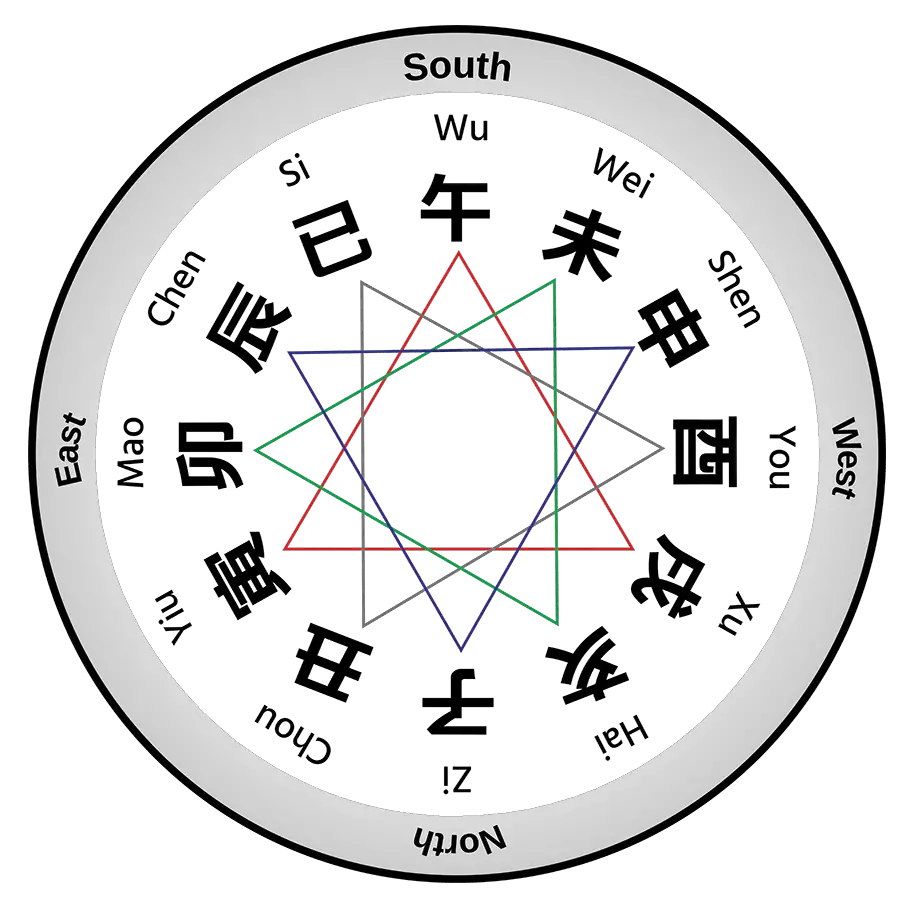

1. Locate your animal sign on the chart.
2. Count until you reach the fourth sign away from yours (both clockwise and counterclockwise).
3. Note the signs you land on.
The fourth animal signs from yours (no matter the direction) are your most compatible signs. For example, a Wu Horse person is most compatible with Xu Dog going clockwise, and Yin Tiger going anti-clockwise.
Click on your Animal Sign to find out your full Chinese Zodiac compatibility information -
Compatible Groups
An extension to the single compatible Chinese zodiac signs, there are also compatible groups known as San He (三合). The twelve animals are divided into four groups, each with three animals. The three animals within any particular group are considered beneficial connections and may bring good luck to one another in life. For example, a Rabbit, Goat, and Pig can usually live harmoniously and help one another out.
Fertility/Pregnancy
In addition to compatibility, Chinese astrology (and Feng Shui!) can provide some insight into fertility and pregnancy.
The Ba-Zi chart offers detailed information and clues regarding fertility. It utilizes the Five Elements to determine whether a couple is likely to become pregnant and how many children they can expect to have.
In addition to predicting the best times for fertility, some Chinese astrologers also use the lunar calendar to predict the gender of a baby. To determine this, you’ll need the age of the mother when she was born and the month of conception.
Here’s how to determine whether you’re having a boy or a girl based on Chinese astrology:
1. Locate a Chinese conception calendar.
2. Calculate your lunar age at conception and note your conception month.
3. Find your age at conception on the chart (along one axis).
4. Locate the month of conception (along another axis).
5. Slide your finger on the chart to find where these two aspects meet.
The area where the two axis intersect will say whether you’re predicted to have a boy or a girl.
Like this article? Tap to share
Lovers and Cheating
Most people look to astrology in hopes of finding they mesh well with a potential partner. Sometimes, however, those in a committed relationship want to know if there are any indicators in the chart suggesting challenges within the relationship.
A Chinese astrology natal chart can provide that information. Conflicting zodiac sign or elements may appear in certain areas, possibly indicating infidelity, divorce, or other relationship issues.
This section isn’t here to call out certain signs or make sweeping generalizations, because there can also be deeper hidden combinations in a person’s chart that mean they are always searching for the right person, even if they are in a relationship.
Remember that there’s far more to a person than their Chinese zodiac sign. There could be additional elements within a chart, making them less likely to stray. It’s important to look at the chart as a whole, instead of focusing only on the zodiac signs.
6 Chinese Zodiac Signs with a tendency to Infidelity
• Rat – Rats aren’t usually content with settling down right away. A rat may flirt, date, and even lead people on without ever assuming they’re “locked down.” Therefore, potential partners should ensure that their expectations for the relationship are clear. Once in a committed relationship, rats can be loyal partners.
• Tiger – Tigers are charismatic and enjoy mindless flirtation — but it could lead people on. Additionally, tigers need plenty of reassurance within a relationship, especially when they’re young. If they don’t feel validated, they may use it as an excuse to look elsewhere for their confidence boost.
• Dragon – Dragons can be victims of flattery. They enjoy having their ego stroked, so it’s easy for them to develop feelings for anyone who compliments them regularly. Young-minded Dragons have trouble resisting the temptation.
• Snake – Snakes are notorious for their wandering eye — but they’re not all like this. Confident, self-aware Snakes do not require the same reassurance that younger, insecure Snakes often do. Watch out for the Snakes that regularly seek outward attention — they may be looking for another relationship.
• Horse – Horses are fully capable of maintaining a faithful, loving relationship, but their constant need for stimulation makes them prone to boredom. A disinterested horse may run off from time to time in search of adventure and excitement.
• Pig – The sensitive Pig often finds themselves getting lost in romance. It makes them feel special, even if it’s just mindless flirtation. This type of naivety can leave a Pig easily manipulated, driving them to infidelity even though they know better.
In addition to single signs with a propensity for infidelity, there are also incompatible groups that may help you determine whether your partner can stay loyal.
Incompatible Chinese Zodiac Signs
The incompatible groups, also called Liu Chong (六冲) use the Earthly Branches to determine which signs conflict with one another. Two signs within a group have a higher chance of disagreements, fights, unhappiness, and potential infidelity as a result.
For example, an Ox and Goat may have similar characteristics, but they do not mesh well overall. They could clash regularly, causing serious issues within the relationship.
Take a look at the Liu Chong chart below to view the incompatible groups:
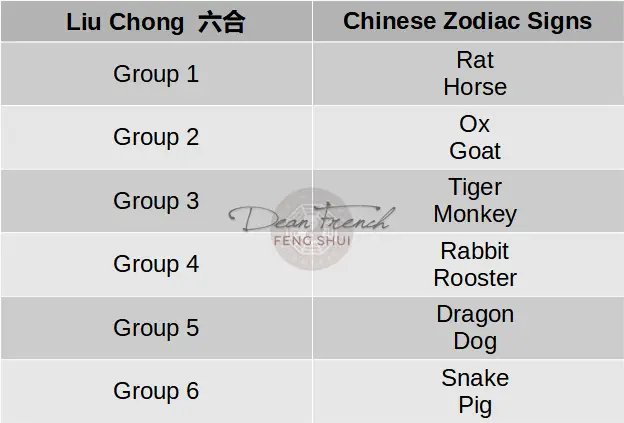
Then there are the “Harming Groups.” These groups, also known as Liu Hai (六害), have a likelihood of hurting one another based on differing opinions, disagreements, and undermining each other. In fact, signs within each group are notorious for purposely hurting one another, whether physically, mentally, or emotionally. These combinations could certainly indicate infidelity.
Check the Liu Hai chart below to determine if you and your partner sit together in a Harming Group:

In addition to the “Six Harms”, there are the “Six Damages”, the “Three Penalties” and finally, four of the Chinese zodiac signs that should avoid dating their same sign altogether. The following four signs are referred to as “self-punishing,” or Zi Xing (自刑):
• Dragon
• Horse
• Rooster
• Pig
If one of the above signs dates or marries someone of the same sign, it indicates trouble right off the bat. Issues within the relationship are nearly guaranteed, as these signs tend to “self-punish,” often sabotaging partnerships early on. This is especially true during their Ben Ming Nian (the year that shares their same animal sign).
For example, let’s say that a Rooster and another Rooster marry. The two already have a tendency to fight with one another to see who’s on top in the pecking order.
Friendships and Family Relationships
The Chinese compatibility charts aren’t simply for romantic partnerships. You can use the information within these charts to determine compatibility among friends, family, acquaintances, and even work colleagues.
The Six Compatible Groups, or Liu He (六合) can help. This chart determines compatibility using a table with six groups and two animals within each. The two animals within a specific group typically work very well together, helping each other throughout life.
You can also use this chart in conjunction with other compatibility tables for love interests.
However, keep in mind that even if the results aren’t ideal, it doesn’t mean that you need to pack up all of your things and move out of your family’s home or quit your job. It simply means that you may need to work harder on the relationship to bond or work together and avoid becoming estranged.
View the Liu He chart below:
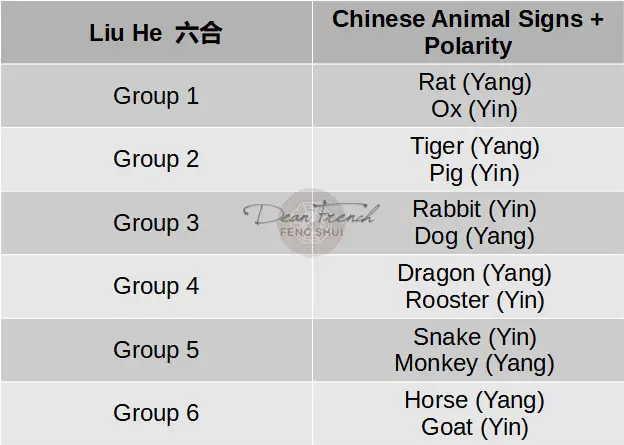
Ability to Attract and Keep Wealth
Another common reason that people use Chinese divination is to determine whether they’re able to attract and keep wealth during their lifetime.
The basic Chinese zodiac signs (based on your year of birth) can provide a general overview of financial success. For example, the Ox is a hard worker usually destined to receive a decent fortune in life, thanks to their diligence. The Dragon is considered a lucky sign which may suggest financial reward.
Of course, there are better ways to determine whether you’ll experience luck in your money or career path. One method is by using the month and hour pillars in the BaZi system.
Look for conflicting and complementary factors. Harmonious signs within these pillars indicate good chances for wealth, success, and a lucrative career. Conflicting aspects can indicate financial strain, poverty, or career troubles.
In BaZi, another method is to look for the Day Master’s Wealth Element in the Stems and then find the corresponding Element in the Branch Hidden Stems. This shows that the person can bring in wealth, and can keep it safe.
Illness Forecast, Health Improvement and Anxiety Management
For each Chinese zodiac sign, there are associated bodily organs. For example, the body parts associated with the Rat are the eyes, heart, and urinary tract.
You can use this information to determine your susceptibility to certain medical problems. See the chart below for examples of potential health issues based on the Chinese zodiac sign:
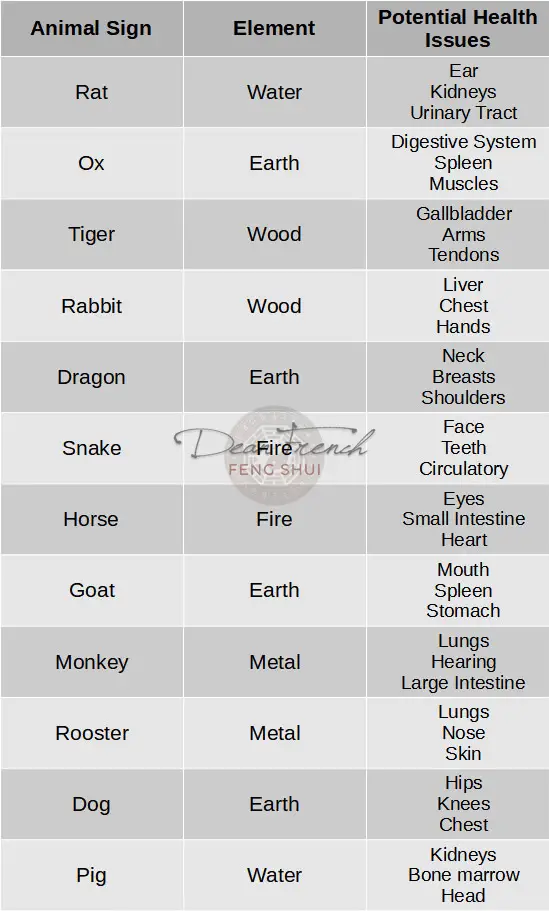
However, it’s best to utilize multiple forms of divination to develop an accurate picture that can forecast illness, tell you the best ways to improve your health, and learn how to improve mental health issues, such as anxiety and depression.
In addition to a sign’s susceptibility, they’re also influenced by the current year. For example, during the Year of the Rat in 2020 (which featured a super strong Water element draining Metal), everyone — regardless of their sign — had a higher likelihood of experiencing adverse health issues. Obviously this manifested in Co-Vid with the lungs (Metal) being attacked by the Rat’s Water. A similar situation occurs in 2023 Yin Water Rabbit, with Water element being attacked by very strong Wood.
Aside from the basic Chinese zodiac chart, you can analyze the Day Pillar in the BaZi system. This pillar sheds light on the health of a person and their immediate family members. For example, if the Spouse Palace is clashed, then the person’s partner can be the one to get sick.
Selecting Good Days for Important Events
So, you want to plan a wedding, family reunion, or day to break ground on your new house — but how do you know which day to choose?
Most people start by checking the weather. Others consult with Chinese astrological systems.
There are an enormous number of methods for Date Selection coming from all the different systems of Chinese Astrology. The difficultly lies in deciding which one is the most suited for the activity you have planned.
The tong shu almanac tells you the general flow of days with the 12 Officers, BaZi can tell you day-to-day interactions between your chart and the current date. Xuan Kong Da Gua is an excellent system for determining the best day to change your Feng Shui.
There are even methods that combine with Feng Shui that tell you which direction to approach a building from, for example where to enter the court to help win a legal case.
Chinese Astrology and Feng Shui
Chinese astrology and Feng Shui are intimately entwined. Feng shui utilizes ancient Chinese philosophy to increase positive energy and energy flow within a space. Most people associate Feng shui with home decorating, but Feng shui goes beyond furnishings and decor.
In fact, you can use the power of Feng Shui to improve the energy within your self. Make it even more powerful by using it in conjunction with the Chinese zodiac and your corresponding elements.
Understanding The Lo Shu Bagua
The Bagua is a 3 x 3 map featuring eight sections and one center space. Each section contains its own fundamental principles that occupy each space, along with a corresponding element and color.
Here is an example of the Lo Shu Bagua:
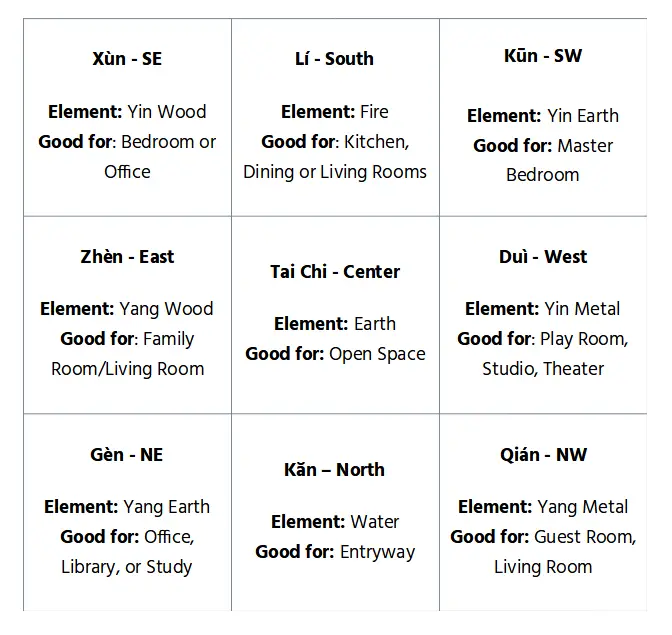
What most people don’t know is that each of the 9 sectors contain the Heavenly Stems and Earthly Branches.
Here is a list showing the 24 mountain directions which are a sub-set of the 8 major directions. The Stems Wu Yang Earth and Ji Yin Earth are located in the center.
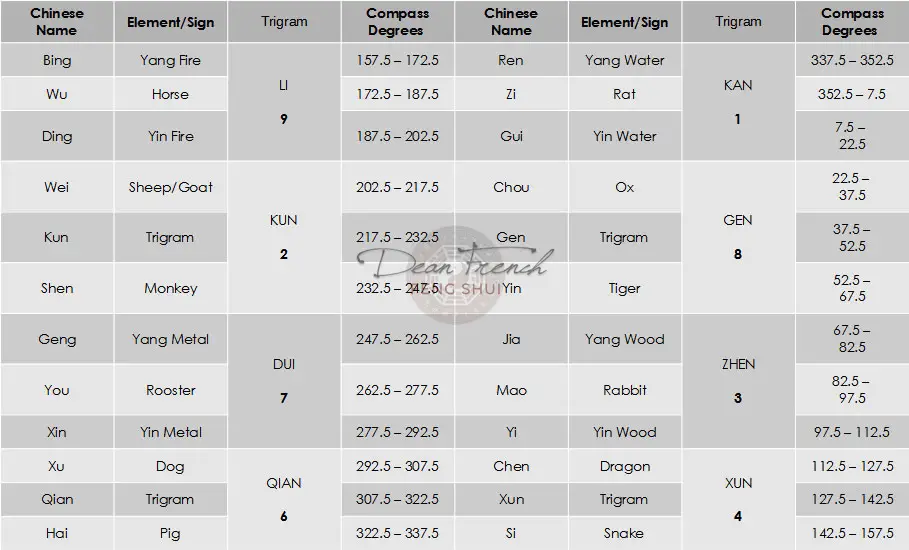
The Five Elements and Animal Signs
The Five Elements play an important role in Feng shui. You can incorporate different elements into specific areas to encourage the flow of Qi (vital energy) throughout a space.
For example:
• Wood – The Bagua features both hard and soft wood. Overall, wood signifies family, wealth, and abundance. Use wood within the Xùn section to encourage prosperity and use wood in the Zhèn spaces to promote a feeling of community. In addition, incorporate the Tiger or Rabbit for optimal energy flow.
• Fire – Representing passion, fame, and reputation, it makes sense that fire is symbolized by the color red. This element and its corresponding color are best suited for placement in the Lí section (Fame and Reputation) of the home. Also, implement Chinese zodiac animals associated with fire, including the Snake or Horse.
• Earth – Self-care, partnerships, and health are all reflected by the Earth element. This element does well in the Gèn, Tai Ji (center), or Kūn sections of the home. It’s symbolized by the Ox, Dragon, Goat/Sheep and Dog.
• Metal – Metal is an efficient material best suited for the Qián (hard metal) or Duì (soft metal) sections of the Bagua. These elements encourage self-cultivation, so it makes sense to place it in the Children’s center or the Spiritual Life section. The animals associated with metal are the Monkey and Rooster.
• Water – Water affects the career and relates to the overall shifting and flowing of energies. Keep this element in or near the Kăn section to help you along on your overall life path. The Pig and Rat are the zodiac animals associated with the element of water.
Is Chinese Astrology Accurate?
In conclusion, the accuracy of Chinese astrology remains a subject of intrigue and debate. Throughout history, Chinese astrology has been deeply ingrained in the cultural fabric of China and neighboring regions, shaping the lives of millions and guiding crucial decisions. While many individuals attest to the accuracy of their astrological readings and its profound impact on their lives, skeptics argue that the interpretations are vague and generic, allowing them to resonate with a wide range of people.
However, it is crucial to recognize that Chinese astrology’s value extends beyond its predictive capabilities. As a cultural practice, it serves as a medium for personal reflection, self-awareness, and fostering a sense of community. Its symbolic system also enriches artistic expressions and cultural festivities.
At a basic level, Chinese and Western astrology seem quite similar. However, according to many astrologers, the in-depth forms of Chinese Astrology can be more accurate when it comes to the minutiae of life.
My area of expertise is in BaZi Four Pillars, and I know that this form of Chinese astrology can shed light on multiple aspects of your life. It’s all about rigorous study and research, or finding a practitioner who can fulfil your requests.
Chinese Zodiac and Astrology Resources
Learn the Ancient Chinese Arts of Feng Shui, Lunar Chinese Astrology, and Solar Chinese Astrology with Dean’s Comprehensive Bundle!
Get everything you need to start learning these ancient arts in one convenient bundle. This bundle includes detailed course notes and examples covering everything from the basics of Feng Shui to the more advanced concepts of Lunar Chinese Astrology and Solar Chinese Astrology.
They are clear, concise, and easy to follow, especially for beginners. You’ll learn everything you need to know to improve your life with the help of these ancient arts.
Limited time offer: Get a $150 bundle discount ($747 down to $597) when you purchase all three courses today!

